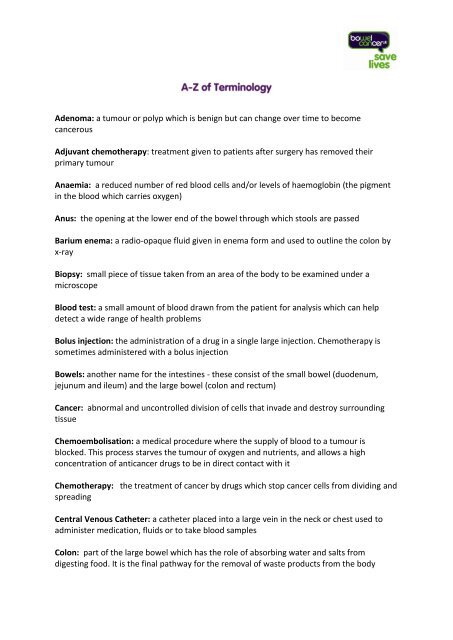Create successful ePaper yourself
Turn your PDF publications into a flip-book with our unique Google optimized e-Paper software.
Adenoma: a tumour or polyp which is benign but can change over time to becomecancerousAdjuvant chemotherapy: treatment given to patients after surgery has removed theirprimary tumourAnaemia: a reduced number of red blood cells and/or levels of haemoglobin (the pigmentin the blood which carries oxygen)Anus: the opening at the lower end of the bowel through which stools are passedBarium enema: a radio-opaque fluid given in enema form and used to outline the colon byx-rayBiopsy: small piece of tissue taken from an area of the body to be examined under amicroscopeBlood test: a small amount of blood drawn from the patient for analysis which can helpdetect a wide range of health problemsBolus injection: the administration of a drug in a single large injection. Chemotherapy issometimes administered with a bolus injection<strong>Bowel</strong>s: another name for the intestines - these consist of the small bowel (duodenum,jejunum and ileum) and the large bowel (colon and rectum)<strong>Cancer</strong>: abnormal and uncontrolled division of cells that invade and destroy surroundingtissueChemoembolisation: a medical procedure where the supply of blood to a tumour isblocked. This process starves the tumour of oxygen and nutrients, and allows a highconcentration of anticancer drugs to be in direct contact with itChemotherapy: the treatment of cancer by drugs which stop cancer cells from dividing andspreadingCentral Venous Catheter: a catheter placed into a large vein in the neck or chest used toadminister medication, fluids or to take blood samplesColon: part of the large bowel which has the role of absorbing water and salts fromdigesting food. It is the final pathway for the removal of waste products from the body
Colectomy: removal of the colon by surgery. Partial colectomy is the removal of a portionof the colonColonoscopy: the passing of a long, flexible, narrow tube through the anus to inspect thelining of the rectum and colon (bowel)Colostomy: the end of the colon is brought to the skin surface on the abdomen to form anexternal channel for the passage of stools into a colostomy bagColorectal Nurse Specialist: a nurse who has received specialist training and is experiencedin all aspects of bowel conditionsConstipation: incomplete or infrequent bowel motions. This can cause straining anddiscomfort when passing a stoolCryotherapy: an alternative form of cancer treatment where needles are used to applyfreezing gases to cancerous cells in order to destroy themCT scan: (computerized tomography) a high quality x-ray with the ability to examine softtissue, i.e. not solid material like bone, by giving a cross sectional image of ‘slices’ of thebodyDiarrhoea: an excessive number of loose and watery stools which are often passedfrequently and with urgencyDigital rectal examination: a gloved finger is used to feel for any abnormalities in the backpassage (rectum)Dukes’ staging: a system devised by Cuthbert Dukes that describes the spread of thetumour and forms the main component in identifying the ‘stage’ of bowel cancerEnema: the passing of a small tube through the anus to allow the introduction of a quantityof fluid into the rectum. This is used to relieve constipation or to empty the bowelFaeces: bowel motions; stools; also called waste and pooFamily <strong>Cancer</strong> Genetics Clinic: a specialist clinic where people with a significant familyhistory can be screened and given specific genetic adviceFibre: a substance found in foods that come from plants, fruits and vegetables. Fibre helpsto aid digestionFlatus: gas in the stomach or intestine commonly referred to as ‘wind’ when passed throughthe rectum
Faecal Occult Blood (FOB) Test: a kit to test for traces of hidden (occult) blood in the stools.Used in the national screening programmesFlexible Sigmoidoscopy: a long flexible lighted tube passed through the anus into therectum and into the sigmoid colonGastroenterologist: a physician specially trained in the diagnosis and treatment of disordersof the gastro intestinal tractGene (genetic makeup): the inherited characteristics of an individual; the blueprint of lifeGenetics: the study of inherited genesGut: the word commonly used for the digestive tractHaemorrhoids (Piles): enlargement of the normal spongy blood-filled cushions in the wall ofthe anusHemicolectomy: surgical removal of about half of the (generally) right side of the colon withsubsequent joining of the remaining colonHickman line: a fine plastic tube inserted into a large vein through the chest wall generallyfor people receiving long-term chemotherapyHistopathology: the examination of tissue from the body under a microscope to spot thesigns and characteristics of diseaseIBD: Inflammatory <strong>Bowel</strong> Disease - a general term for chronic inflammatory disordersaffecting the small and/or large intestine e.g. Crohn’s disease, Ulcerative ColitisIleocaecal valve: the valve at the junction of the small bowel and large bowel which controlsthe back flow of waste productsIleostomy: an opening into the ileum, part of the small intestine, from the outside of thebody. An ileostomy provides a new exit for waste materialIntravenous Infusion: the introduction of a solution (such as various chemotherapytreatments) into the body via a veinLaparoscopic Surgery: commonly called ‘keyhole surgery’. Several small incisions are madein the abdomen allowing a laparoscope (a small viewing camera) and specialised surgicalinstruments to view and operate on the tumourLaparotomy: a surgical incision into the abdominal cavity to examine abdominal organs
Large bowel: the colon, rectum and anusLaser Therapy: a surgical procedure whereby a narrow beam of light called a laser is used toremove cancerous cellsLesion: an area in a tissue or organ that has suffered damageLiver Biopsy: a medical procedure to obtain a small piece of liver tissue for diagnostictestingLymph nodes: a network of vessels which transport fluid from body tissue to the bloodstream, acting as the body’s drainage systemMagnetic Resonance Imaging (MRI): a sophisticated X-ray machine that takesdetailed pictures of internal organs, including the pelvisMalignant: a cancerous tumour which can invade and destroy surrounding tissue andspread to other sites in the bodyMargin: used in medical terms to describe a healthy section of tissue surrounding a tumourMelaena: black tarry faeces (stool) due to the presence of partly digested blood fromhigher up the digestive tractMetastases: secondary deposits of cancer cells that have travelled from the primarytumour site to other organs of the bodyMetastasis/metastatic: a spread of cancer from the original site of the disease via the bloodvessels or lymph channelsMonocolonal Antibodies: a form of biological therapy used with chemotherapy to treatmetastatic bowel cancerMucosa: the name given to the lining of the bowel which produces mucusMucosal Lining: a membrane or lining of the bowel which contains mucus-secreting glandsMucus: clear ‘jelly like’ substance which lubricates the lining of the bowel to ease thepassage of stools. Excessive amounts are produced when bowel cancer is presentMulti-disciplinary team (MDT): a team made up of various health professionals who worktogether to discuss a patient’s case and how best to manage treatment and careNeoadjuvant chemotherapy: chemotherapy given before treatment to remove the primarytumour with the aim of improving the results of surgery
Occult blood: non-visible blood in the stools, which can be detected by a simple laboratorytest known as a faecal occult blood (FOB) testOncologist: a physician who specialises in the diagnosis and treatment of cancerPalliative: medication, treatment or care given for late stage cancer which can help alleviatesymptoms but will not ‘cure’ the cancerPET Scan: Positron Emission Tomography. It can show how body tissues are working as wellas what they look likePolyp: a cluster of cells which project as a growth, usually on a stalk, from the mucosal liningof the bowelPrognosis: a prediction of what might happen in the future i.e. the progress of the diseaseProctoscope: a thin tube containing a light and camera which, when inserted into therectum, allows visual inspectionRadiologist: a healthcare professional who specialises in X-ray, ultrasound and other similarexaminationsRadiotherapy: the treatment of cancer by deep X-rays. Often given for rectal cancer beforeor after surgeryRectum: the lowest part of the large bowel nearest the anusSecondaries: cancer that has spread from the original site to other organs. Also known asmetastesesScan: data or image obtained from the examination of an organ or area of the body. An X-ray is a common example, producing photographs of the internal organs of the bodyScreening: aims to detect bowel cancer at an early stage in people with no symptoms, whentreatment is more likely to be effectiveSelective Internal Radioaction Therapy (SIRT or SIR-Spheres): a non-surgical therapy thatuses radioactive microspheres called Selective Internal Radiation Spheres (SIR-Spheres) todeliver radiation to cancer tumoursSigmoidoscopy: a short, lighted tube passed through the anus into the rectum to inspectthe lining of the lower part of the colon & rectum
Sterile Alcohol Therapy: a surgical procedure where sterile alcohol is injected directly into atumour. This procedure is only suitable for tumours smaller than four to five centimetres inlengthStoma: the opening made through the abdomen for the passage of stools into a colostomybagStoma Nurse: a specialist nurse trained in the care of patients who have had a stoma, theircarers and familiesStools: motions, faeces, waste, pooTNM: a system of staging of the disease. T=size of tumour; N=number of lymph nodes affected;M=spread of cancer to other organs i.e. metastatic spreadTotal Mesorectal Excision (TME): a surgical procedure which removes the tumour andsurrounding tissue in order to help prevent the recurrence of bowel cancerUltrasound or Ultrasonic Waves: inaudible sound waves which are used to examine thestructure of the inside of the bodyVirtual Colonoscopy (CT Colonoscopy): a non-invasive scan looking at the external andinternal surface of the large bowelX-Ray: a scan which produces data or images of internal bones and organs













